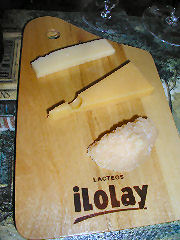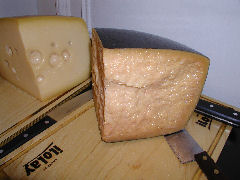“Cheese is milk’s leap towards immortality.”
– Clifton Fadiman, Radio Show Host, Information Please (1938-1948)
 Buenos Aires – A few weeks ago I was invited to participate in a series of cheese tastings sponsored by ArgentineWines.com. I’m not exactly clear the purpose of these tastings – I thought I was – but it seems that each week (there are five, and I missed the first one) we sit down and taste three cheeses. We spend about two hours doing so. Then we retaste them all up against three or four wines. We spend about another half hour or so doing that. Now, you might ask, just exactly what is it they’re doing for two hours tasting cheese… and only three cheeses to boot? Well, it’s been a fascinating process. We’re tasting them using an analytical format that involves all five senses and really gets pretty in-depth. And, of course, there’s a fair amount of joking around.
Buenos Aires – A few weeks ago I was invited to participate in a series of cheese tastings sponsored by ArgentineWines.com. I’m not exactly clear the purpose of these tastings – I thought I was – but it seems that each week (there are five, and I missed the first one) we sit down and taste three cheeses. We spend about two hours doing so. Then we retaste them all up against three or four wines. We spend about another half hour or so doing that. Now, you might ask, just exactly what is it they’re doing for two hours tasting cheese… and only three cheeses to boot? Well, it’s been a fascinating process. We’re tasting them using an analytical format that involves all five senses and really gets pretty in-depth. And, of course, there’s a fair amount of joking around.
We start with the visual – what shape is the cheese, what color, what sort of rind or covering does it have, what does the surface look like, does it have holes in it when it’s cut into, what sort of “microstructures” does it have when you break a piece off. Then we get all tactile with it – elasticity, friability (for lack of a better term, it’s crumbliness) and fragility, how hard or soft is it, how humid is its surface, if you try to ball up a little bit of it does it stick together, how easy is it to chew, does it dissolve well, how does it feel in the mouth. Of course, we smell it and later taste it – and this is where it truly gets fascinating. I’ve done this sort of thing with wine for years, but never sat down with a cheese in front of me and had to try to come up with words to describe what it tastes like.
The various aromas are divided into “families” – lactic, vegetal, floral, frutal, roasted, animal, spices, others. Those are further divided into subfamilies, and from there into the individual flavors. When you have to think about it there are clear differences in the smells, for example, of milk, cream, yogurt, butter, browned butter, etc. It’s also pretty interesting to realize what a range of aromas an individual cheese has that go into the overall experience. The taste part is focused more on how the aromas change when you’re chewing the cheese rather than just smelling it, along with things like salt, sweet, bitter, sour, umami – the new standard of five tastes, plus things like picante, or spicy; and sensations, like refreshing or burning, acid or alkali…
And, we even end up with “listening” to the cheese – quite simply, does it make noise when you chew it – primarily crunchy or squeaky noises.
Now, not that I’m remotely a cheese expert. Nor that I’ve even begun to really taste my way through the world of cheeses. I’ve had lots of them, but beyond the process, what has been great for me is tasting cheeses I’ve never tried before. Out of the last three weeks, one of the three cheeses each time has been one that I was completely unfamiliar with. Not one of them is listed in the generally encyclopedic look at the world of cheese that is Steve Jenkins’ Cheese Primer. In fact, out of a 548-page book the only mention that Argentina gets is a dismissive sentence about parmesan from Argentina and Uruguay. Not one other mention of any cheeses of South America is even made. Argentina produces approximately 7.3% of the world’s cheese, something worth considering.
 So, the three new cheeses I’ve “discovered”?
So, the three new cheeses I’ve “discovered”?
Fynbo – a cheese originated on the isle of Fyn Fynbo in Denmark, it’s a cylindrical semi-hard cow’s milk cheese that had all sorts of interesting flavors in it – the shining note for me was an intense aroma of buckwheat, sort of like buckwheat pasta cooked in lightly browned butter.
Pategras – a semi-hard cow’s milk cheese in the Gouda family. I’m not clear if pategras is actually made in the Netherlands where Gouda originated or if it’s more of a South American take on the cheese. This is creamier than a traditional Gouda (which is also available here) and is used more with desserts. It’s got a delightful flavor like freshly roasted peanuts, along with a creamy sort of finish.
Trebolgiano – a hard grating cheese in the Reggiano family – as best I can tell only produced in Argentina, rife with crystals from aging, and an interesting color that borders on reddish (this is the cheese pictured here). An amazing range of flavors that kept us discussing for quite a long time – dates, yogurt, beef extract, roasted tomatoes and celery – it was like one of Willy Wonka’s meals in a gumball.
One or two more tastings to go, hopefully each with new discoveries!
Fynbo is a gooood. I use it a lot as a substitute for mild/medium cheddar or monterey jack. Kind of sits right in between the two on taste and texture, for me at least.
[…] Buenos Aires – Yesterday morning started off with another round of our cheese tasting group. This week it was a trio of simple “Argentine blues” – no further designation like “roquefort”, “gorgonzola”, “cabrales”, or “stilton”. Just “blue“. This time the idea was to come up with the differences in three producers’ styles – Sancor, La Quesera, and Ilolay – so we tasted them side by side without knowing which was which until after the fact. They were indeed significantly different: […]
[…] So, a fascinating day, and probably more to come in the future – I’d like to try out some of their more “practical” courses that involve actual cooking, and we’ll see where it leads. Now, I’m off for the last round of cheese tasting… […]
[…] Apparently gratined fish is quite popular in the cuisine. Hake is, I gather, a favorite, here called merluza. Though slightly elaborate looking, this was pretty simple. The fish filets are cleaned and deboned and placed in a cazuela, or any similar ovenproof dish. I blanched and shocked some spinach and then pureed it into a mix of milk and cream (an idea I got from a recent lunch at José Luis), seasoned with salt and lots of paprika, and then poured it around the fish. Saute onions until just transluscent and limp, and place atop the fish, and then top the whole thing with some grated cheese – I used fynbo which has a rich, earthy note of buckwheat to it. Then stuck in the oven until cooked through and lightly browned on top. […]
I’ve never seen trebolgiano here, but now I really want to try it! I agree with asadoarg that fynbo works well as a substitute for a mild cheddar/monterey jack. It’s my go-to cheese when I make Tex-Mex!
As of a week or so ago, the Disco near me had a wheel of the trebolgiano from Ilolay – I think they were selling it for $200/kilo.
As far as I know, Trebolgiano is basically a Parmeggiano variation made by a dairy in the town of El Trébol, Santa Fe, Argentina. “Trébol” is the Spanish word for shamrock. This info I gathered at a cheese fair in my town, where we had the chance of tasting varieties from different parts of Argentina.
This post was from 18 years ago – since then, I’ve looked into the history of this cheese. In 1912, an Argentine cheesemaker Esteban De Lorenzi traveled to Italy to research various cheeses, and ended up hiring a local cheesemaker, Oberdan Giri, to come back with him to El Trébol. In addition to helping improve their cheesemaking techniques, one of his goals was to create a cheese that was a worthy competitor to Parmigiano-Reggiano. Trebolgiano, in Italian, means “from Trebol”. The De Lorenzi cheese company was acquired by a much larger company, Sucesores de Alfredo Williner S.A., in 1978, and they continue to produce Trebolgiano as one of their main cheeses, though it’s not all produced in El Trébol anymore.